Output-Feedback Nonlinear Adaptive Control Strategy of the Single-Phase Grid-Connected Photovoltaic System
Abstract
This paper addresses the problem of controlling the single-phase grid connected to the photovoltaic system through a full bridge inverter with LCL-filter. The control aims are threefold: (i) imposing the voltage in the output of PV panel to track a reference provided by the MPPT block; (ii) regulating the DC-link voltage to guarantee the power exchange between the source and AC grid; (iii) ensuring a satisfactory power factor correction (PFC). The problem is dealt with using a cascade nonlinear adaptive controller that is developed making use of sliding-mode technique and observers in order to estimate the state variables and grid parameters, by measuring only the grid current, PV voltage, and the DC bus voltage. The control problem addressed by this work involves several difficulties, including the uncertainty of some parameters of the system and the numerous state variables are inaccessible to measurements. The results are confirmed by simulation under MATLAB∖Simulink∖SimPowerSystems, which show that the proposed regulator is robust with respect to climate changes.
1. Introduction
The global concern about climate change and the growing energy demand of industrialized countries have necessarily led to exploring other new sources like the renewable energy. The main advantages of this type of renewable energies reside in the reduction of pollution caused by the production of greenhouse gases. Among different types of these energies, the photovoltaic energy has obtained a great attention.
The photovoltaic energy systems are classified according to their use. The two principal classifications are grid-connected systems and stand-alone systems. The first one is connected to the grid through a three-phase or single-phase inverter; this category is used to deliver the power directly to utility grid and must be properly controlled according to power electrical legislations. The second one is used with a battery bank for electrifying remote rural areas.
The power factor correction, the DC output voltage regulation, and the maximization of the power provided by the PV modules are the main control objectives for allowing high power quality to the grid. To meet these requirements, various control methods have been proposed in [1–3]. Indeed, [4] proposed a passivity based control. However, this technique requires being in a passive state. In [5], the proportional resonant (PR) controller is designed. The latter provides acceptable dynamic performance and eliminates the steady-state error. In [6, 7] a sliding-mode controller (SMC) is used to have an excellent robustness and a very good steady-state performance as well as a fast-dynamic response. In [8] the authors propose a control law based on backstepping [9] and Lyapunov function so as to stabilize the global system.
In the literature, a few papers dealt with state-feedback control [10] and state observer design at the same time. In [11] a state-feedback control law is combined with observer to enhance disturbance rejection capability of a grid-connected photovoltaic inverter. In order to achieve the third goal, it is important that the PV system operates at its optimal power point, and for this task a maximum power point tracking is required.
- (i)
Perfect power factor correction (PFC): the grid phase currents and its corresponding voltages must be in phase.
- (ii)
DC output voltage regulation: this voltage must be tightly regulated to a constant reference value to ensure the power exchange between AC grid and the DC bus.
- (iii)
Maximization of the power provided by the PV models.
- (i)
Several control objectives are simultaneously considered (MPPT, DC Regulation, and PFC) while only some of these objectives have been tackled in previous works [12, 13].
- (ii)
The nonlinearity of the controlled system was preserved [14] in order to keep all the properties of the studied system.
- (iii)
The grid voltage is not accessible to measurement and the internal impedance is assumed to be unknown, unlike previous works which assumed that voltage is available and the grid impedance is null or known [15–17].
- (iv)
The present nonlinear adaptive control system does not necessitate many sensors for the measurement of some needed variables unlike previous works [18].
The paper is structured as follows: in Section 2, a mathematical model and description of all system stage are described. In Section 3, the design of the cascade nonlinear adaptive controller is presented. Section 4 covers the simulation results and discussion about the results. The conclusion is in the end.
2. System Description
This section describes the modelling of photovoltaic system connected to the grid. The power plant under study is shown in Figure 1. It consists of a PV panel, a DC-DC boost converter that drains the energy from the photovoltaic module and feed the DC bus capacitor, and a full bridge single-phase inverter with LCL-filter used at the output of the converter to achieve a satisfactory total harmonic distortion of the injected current.
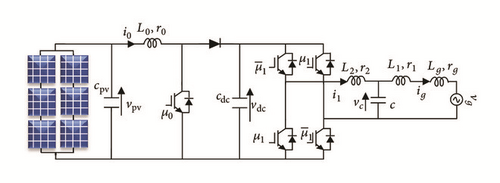
| Variables and parameters | Definition | Observation |
|---|---|---|
| x1r | vg/(L1 + Lg) | Nonaccessible to measurements |
| x2r |
|
Nonaccessible to measurements |
| θ1 | (r1 + rg)/(L1 + Lg) | Unknown parameter |
| θ2 | 1/(L1 + Lg) | Unknown parameter |
3. Control Strategies of the System
In this section, an output-feedback nonlinear controller will be synthetized. As represented by the averaging model (3a)–(3f) the system has two control inputs (u0, u1). The controllers (Figure 2) will be designed to achieve the three main objectives mentioned previously.
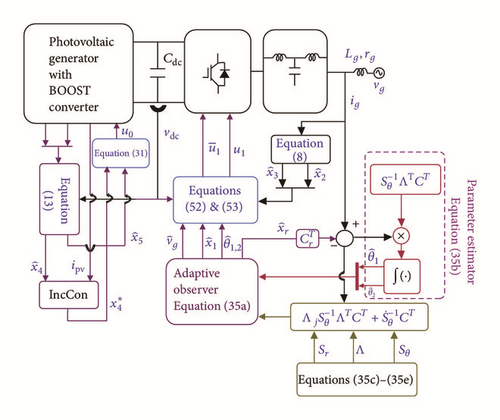
In addition, the observers are designed to estimate the values of unmeasurable states. The first task is dedicated to the design of the observers and the second task is devoted to development of an output-feedback nonlinear controllers.
3.1. State Observer Design
The purpose of the present subsection is to design the observers, which provide accurate estimates of states variables and use them later to develop an output-feedback controller such that the estimation errors converge to zero. For that, an adaptive observer and Luenberger observer [19] are designed to estimate the state variables (x1, x2, x3, x4, and x5) based only on the measurement of the states (x1, x4).
Obviously y1 = x1 and y2 = x4 are the measured output of the PV system connected to the grid.
The design strategy consists in synthesizing separately an observer for each one of subsystems (6a)-(6b). In the first step, a linear observer is designed for subsystem Σ1. In the second step, an adaptive observer is designed for subsystem Σ2.
3.1.1. Linear Observer
The gain vector M is selected to make A0 = A1 − M C1 a Hurwitz matrix, which will guarantee the asymptotic error convergence.
3.1.2. Adaptive Observer
Proof. To analyze the error system (17), the following Lyapunov function candidate is considered:
3.2. Output-Feedback Controller
The PV output voltage x4 is regulated by controlling the switching device of the boost converter, while the DC-link voltage x6 and the grid current x1 are adjusted through the switching devices of the inverter.
3.2.1. Control of Boost Chopper (PV Voltage Controller)
Proposition 2. Consider the closed-loop control system, consisting of system (6b) in closed loop with the control law (31) and the state adaptive observer error (17). Its dynamic behaviour, expressed in -coordinates, is governed by the following equations:
3.2.2. Control of Single-Phase Inverter
To guarantee high performance transmission of the power and good functioning of the system, the current and voltage grid should be in phase. Hence, there is a necessity for regulator that enforces the estimate current to track a given reference current , where β is computed from the output of the outer loop voltage. The proposed controller uses a cascaded loop: an outer voltage loop and an inner current loop. The former compares the sensing DC bus voltage in the link capacitor with the given reference, whereas the latter uses sliding-mode controller to regulate the grid current allowing the synchronization of the currents ig with utility grid voltages vg.
The stability results are summarized in the proof which can be found in [11]. Therefore, the error system is exponentially stable with a rate driven by ρmin.
Figure 3 shows that, for smaller values of ξ, the function tanh(·) behaves close to a function sgn(s). Figure 4 depicts the errors between sgn(s) and tanh(s/ξ), which shows that the error decreases for small values of ξ.
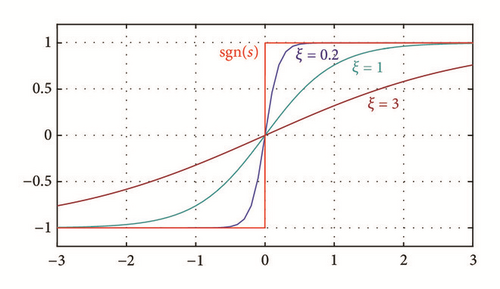
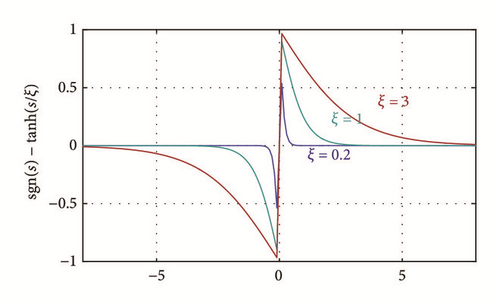
4. Simulation
In this section, the controller that has been designed in the above section using output nonlinear feedback technique will be tested. The simulation results have been obtained under normal conditions (G = 1000 w/m2; T = 25°C) and other different conditions. The whole system (power system and controllers) is simulated with the numerical values of Tables 2 and 3. The parameters of the controllers are determined based on the desired specifications of the closed-loop system. In this paper, the controller parameters are designed so that the current control loop has much faster response than that of the DC-link voltage control loop. In this work the value ξ = 0.1 is used.
| Parameters | Symbol | Value |
|---|---|---|
| Network | En/f | 220 V/50 Hz |
| Boost | Cpv, L0, r0 | 2 mF, 0.3 mH, 5mΩ |
| LCL-filter | L1, r1, C, L2, r2 | 2mH, 5mΩ, 5µF, 2mH, 5mΩ |
| PWM switching frequency | fPWM | 14Khz |
| DC capacitance | Cdc | 4mF |
| Parameters | Value | |
|---|---|---|
| Luenberger observer | m1 | 6399 |
| m2 | 6166 | |
| m3 | 1776 | |
| Current regulator (PFC) | λ, γ | 4500, 40 |
| Voltage regulator | δ, ζ | 44.16, 19.6 |
| DC Link regulator | kp | 88.4e − 8 |
| ki | 695.8e − 8 | |
4.1. Tracking Performance in the Presence of Meteorological Constant
Figures 5–17 show the results of simulation, which are selected to demonstrate the most significant aspects of the PV system grid-connected behaviour. Figure 5 shows that the observers do well. Also, Figures 5(a)–5(e) show that the estimated state provided by the observers converges rapidly due to its true values.
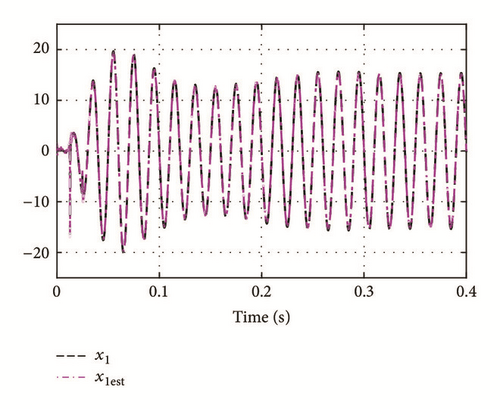
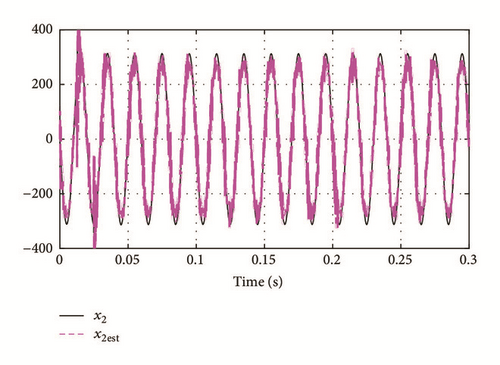
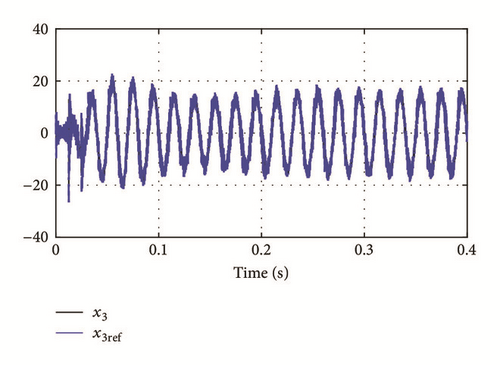
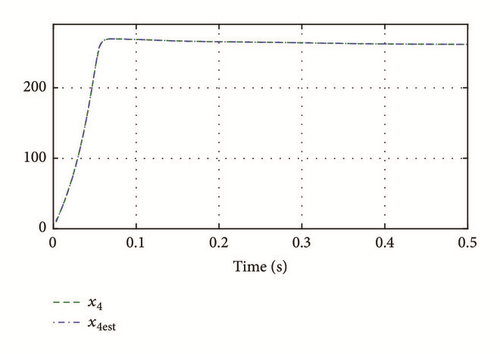
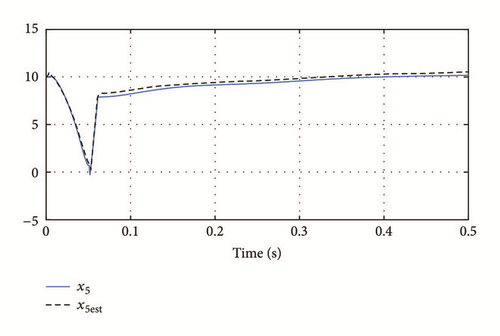
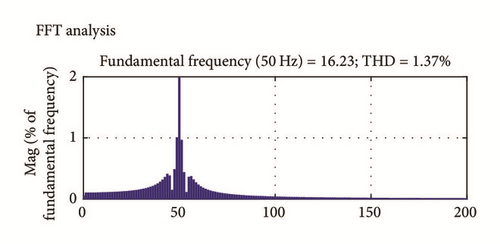
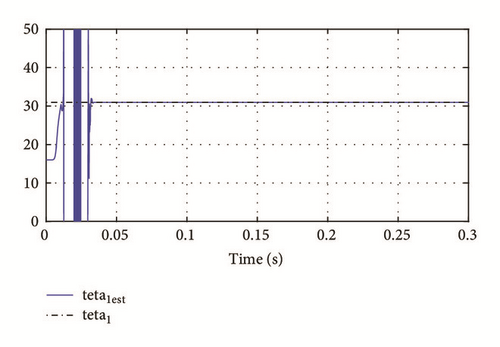


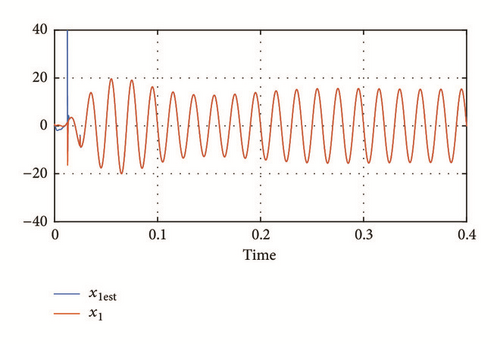

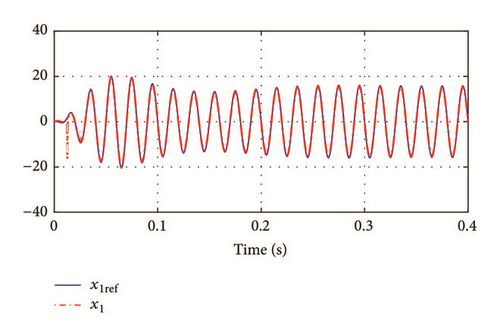
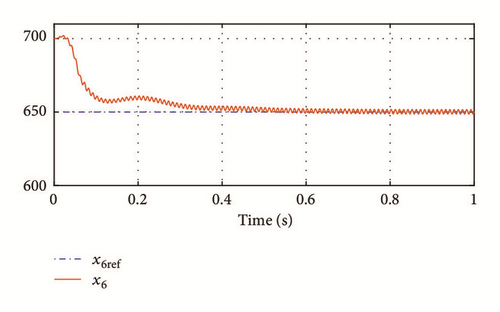
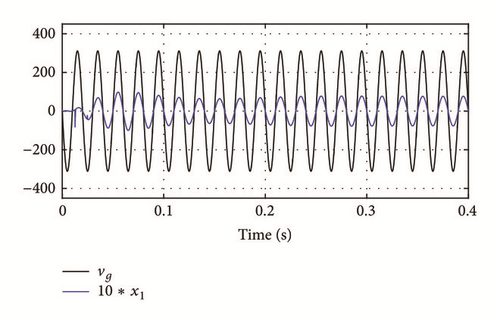
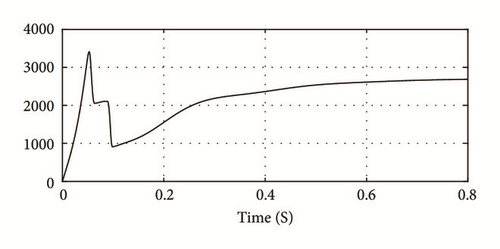

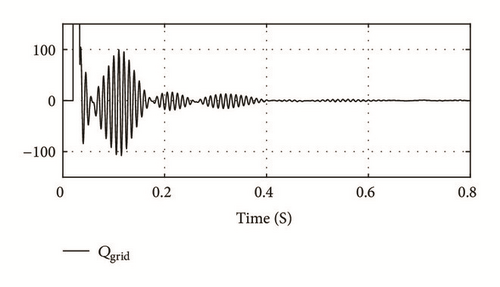
Figure 6 shows the grid current spectrogram, where the THD value of this current is very low equal to 1.37%, which is still below the international standards. The performances of the grid adaptive observer are illustrated by Figures 7–10. Indeed in Figures 7 and 8 it is observed that the estimated parameters and , provided by the grid adaptive observer, converge rapidly to their true values, respectively, (r1 + rg)/(L1 + Lg) and 1/(L1 + Lg) after a short transient phase. Figures 9 and 10 show that the estimated signals of the grid current and of the grid voltages converge, respectively, to their true values x1 and vg = x1r/θ2.
Figure 11 illustrates the response of the PV voltage in standard climatic conditions. It can be clearly seen that, in steady state, the PV generator provides the maximal power, which is equal to 250 V. Figure 12 presents a view of the injected current in the grid with its reference; as it is seen in the figure that the current follows its reference with error nearly 0. Figure 13 shows the regulation of the DC-link voltage. As shown in the figure, the voltage is maintained at a constant level (650 V). Consequently, the real power extracted from the PV generator can be totally transferred to the grid. In the last figure, Figure 14 shows the current injected to the grid. As can be seen in this figure, the current and the grid voltage are in phase and sinusoidal. As a result, a unit power factor is achieved.
Different powers of the system are given by Figures 15–17. Figure 15 shows the power provided by the PV generators. According to Figures 16 and 17, the system injects into the grid active power Pgrid, where the reactive power Qgrid is kept around zero.
4.2. Tracking Performance in the Presence of Meteorological Variation
The robustness of the nonlinear adaptive controller is checked under a time variation climate conditions. The purpose of this simulation is to test the closed-loop system under a change in the PV output that occurred by a sudden change in climate change. In the following simulations, the DC-link capacitor voltage is kept constant equal to 650 V.
The levels of the irradiance are illustrated in Figure 18, which shows that the irradiation has increased from 900 W/m2 to 1000 W/m2 at 0.3 s.
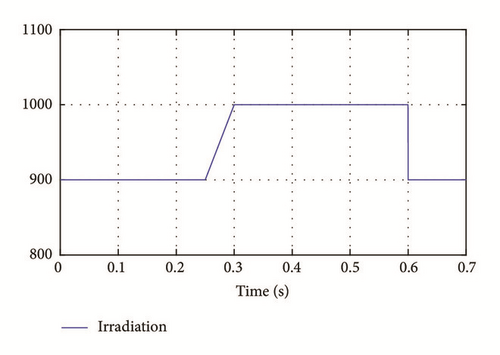
In the following simulations, the output-feedback controller performances are illustrated by Figure 19. The curves (a–c) show that the tracking quality of the proposed observers is quite satisfactory for all supposed unknown states. Figure 19(b) shows that, despite the sudden large change in irradiance, the inner loop ensures a perfect asymptotic tracking of the current reference signal. Figure 19(c) shows that the DC bus voltage regulation is recovered after a short transient period following each change of the irradiation. Finally, Figure 19(d) shows that the correction of the power factor is preserved even during variations of irradiation.
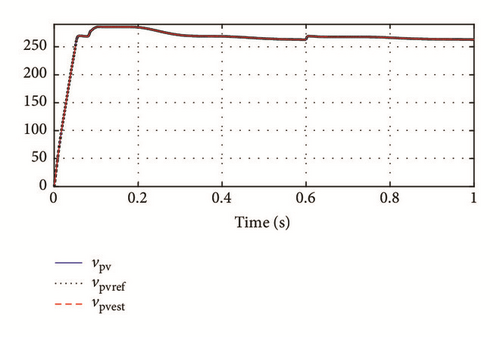

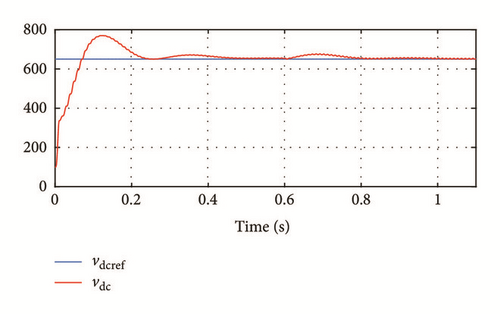

4.3. The Controller’s Ability to Compensate for Variation in Network Impedance Parameters
The aim of this test is to check the grid current controller performance in the presence of variations in the network impedance. The elements of the impedances (Lg) and (Rg) are modified, according to the protocol presented in Figure 20, to generate variations at θ1 and θ2. Note that all system parameters are those used for previous tests.
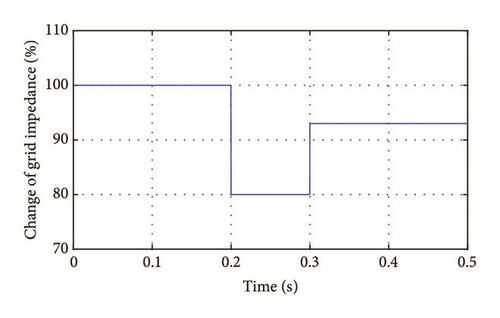
The following figures present the simulation results in the case of variations undergone by the network impedance. Figures 21 and 22 show that unknown parameters and network current estimates converge rapidly to their actual trajectories. Finally, Figure 23 illustrates that the adaptive controller provides satisfactory power factor correction during the uncertainty interval.

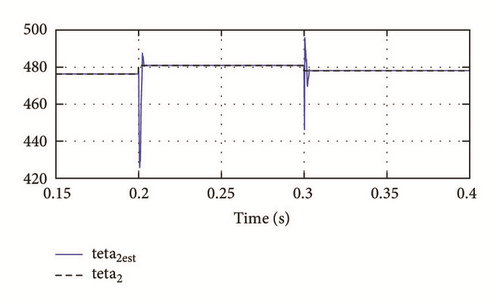

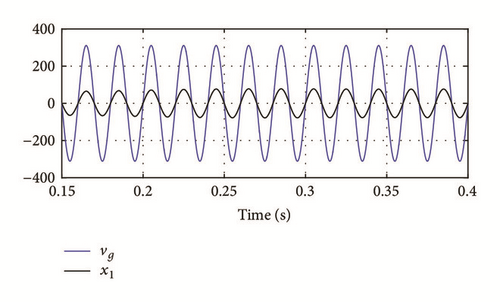
4.4. Tracking Performance in the Presence of Grid Faults
This test aims at evaluating the performance of the system against the change of the amplitude and the frequency of the grid. The amplitude and the reference of the grid are modified according to the protocol presented in Figure 24.
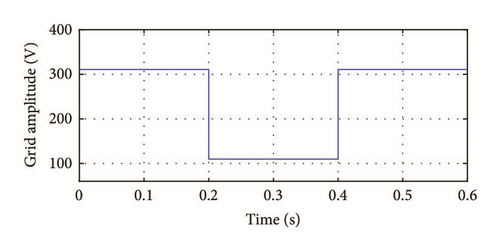
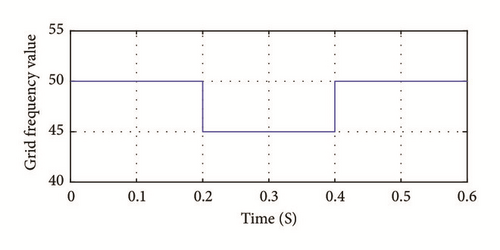
Figures 25 and 26 show that, in spite of the variation of the amplitude and the frequency of the grid, the regulator has the capacity to track the reference provided by the outer loop and to inject a current in phase with the grid voltage.
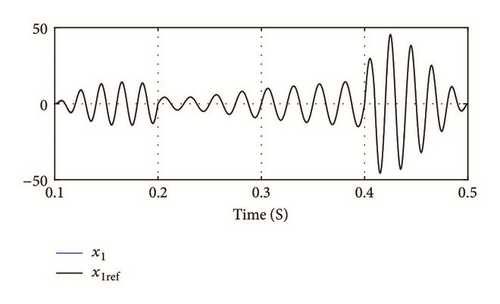
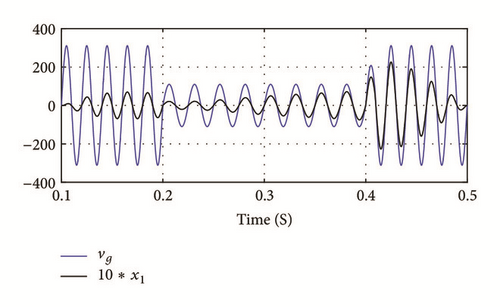
Note that, for all simulations, it is clear that the proposed controller reacts in a quick manner to reach the reference and to remove the steady-state error quickly to keep the stability of the system.
5. Conclusion
An output-feedback nonlinear control strategy for a single-phase grid-connected PV system is proposed in this paper. The system is described by 6th order nonlinear averaged model. The controller design is made based on a combination of robust sliding-mode control strategy and nonlinear observers. The simulations under MATLAB/Simulink prove that the controller meets the performance for which it was designed. Specifically, it is shown that all control objectives are achieved, including PFC requirement, extracting a maximum power from the PV array and DC-link voltage regulation without requiring a lot of current and voltage sensors.
Conflicts of Interest
The authors declare that there are no conflicts of interest regarding the publication of this paper.




